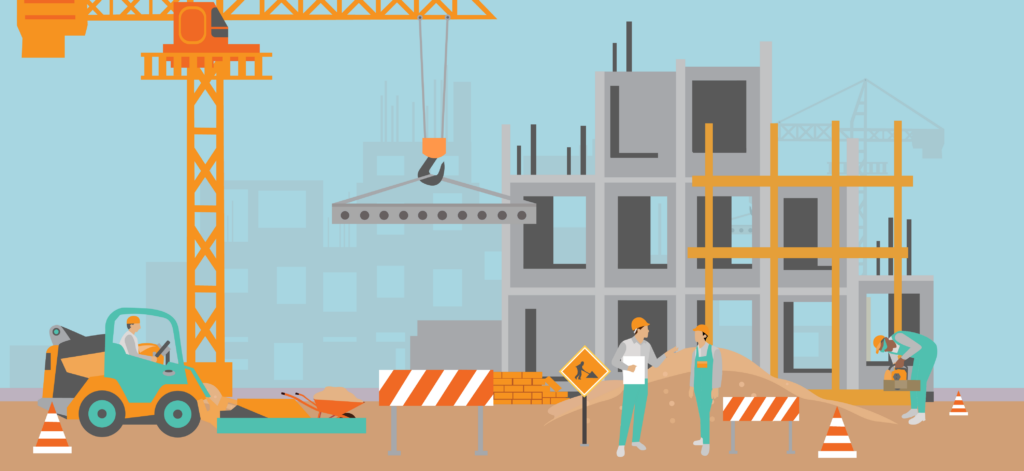
How to beat the heat on your construction site
One of the most common dangers your construction workers encounter during the summer is exposure to heat and hot environments. That’s become especially apparent in recent years given the effects of climate change which have significantly increased storm frequency and temperature extremes. These factors can create a hazardous space for your workers by exposing them to heat stress and illnesses. To protect your workers against heat illnesses, we identify some of the possible dangers they may face along with ways that you can help ensure their health and safety.
Heat stress and heat illnesses are common for construction workers
Heat stress comes from a combination of a hot environment and physical exertion. If your workers are constantly working in direct sunlight, don’t have proper clothing, and are unable to remain hydrated, the body can’t naturally cool itself. In turn, the worker becomes susceptible to these heat-related injuries (HRIs):
- Heat rash: HRIs exist on a spectrum, with heat rash being the mildest. Sweat can get trapped beneath the skin, blocking the sweat glands. This causes red and itchy patches of skin. While the rashes can appear anywhere on the body, they’re most commonly formed on the neck, armpits and elbow creases. These locations are where the skin rubs up against more skin, causing increased irritation. The rash can also form blisters in some cases, which may become infected.
- Heat cramps: Excessive sweating can cause heat rashes along with cramps. The body loses too many electrolytes during exertion, which are needed for muscle contraction. Workers with heat cramps experience discomfort or spasms in the arms, abdomen or legs.
- Heat exhaustion: Long-term heat exposure without sufficient rest and rehydration can lead to exhaustion, causing breathing difficulties, headaches, and cramps. The worker may also experience bouts of nausea, vomiting or diarrhea in some cases. If they continue working, they can sustain bouts of dizziness, a loss of coordination or unconsciousness, posing a significant risk to themselves and others.
- Heatstroke: Workers may experience the aforementioned symptoms of heat rash, cramps, and exhaustion, which indicate heatstroke. The condition can also cause an altered mental state, leading to hallucinations, confusion, agitation and lack of cognition. Heatstroke is considered a medical emergency, requiring a hospital visit to evaluate and treat fully.
Taking safety measures can prevent heat-related worker injuries
Working in hot or humid conditions is unavoidable, but heat injuries and illnesses can be prevented, according to The National Institute for Occupational Safety and Health (NIOSH). Among many other methods, you can protect your workforce through:
- Letting workers acclimate to the conditions: Newer members to your crew are often not accustomed to working in hot or humid environments, leaving their bodies no time to adapt. Experienced workers are also at risk if they wear additional PPE or have returned to a hot working environment after a week or more away. However, their bodies can be acclimatized to the summer heat. Increase their workloads over seven to 14 days to adapt to heat exposure and physical exertion. As the day grows warmer, allow for frequent breaks in air-conditioned rooms and provide ample drinking water.
- Wearing proper clothing: Workers should have mesh safety vests, which help increase airflow. High-visibility clothing reflects sunlight rather than absorbing it, benefiting workers on the hottest summer days. Workers can also use other accessories, like cooling headbands or hardhat sweatbands, to remain comfortable at work.
- Limiting exposure: Modify work schedules by giving frequent breaks, especially for new workers who aren’t yet acclimatized. Schedule more physically demanding work before 10 a.m. and after 3 p.m., which are the coolest parts of the workday.
- Creating awareness: Train workers to recognize signs of heat-related stress, especially dizziness, confusion and cramping. These are indications of an HRI, and when caught early, they can be mitigated before the worker’s condition worsens. Encourage your workers to reach out to a manager if they notice these symptoms in themselves or others. In turn, the manager should be instructed to call 911 if their condition doesn’t improve after resting in an air-conditioned area or if they lose consciousness.
How to find construction workers during any season
PeopleReady has a team of safety specialists around the country who work with our customers to ensure safe work practices are in place. Meanwhile, hiring more workers can decrease the burden on your current staff, enhancing their safety and benefiting your project timeline. PeopleReady provides vetted and reliable workers to fill job openings specific to your field. Whether you need temporary, temp-to-hire or direct hire workers, we have the construction staffing solutions you need to stay on schedule and within budget.

